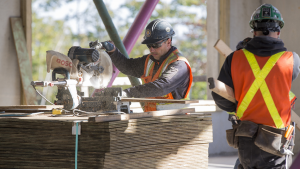OTTAWA — Labour market forecasts vary by province in Atlantic Canada according to BuildForce Canada’s 2020–2029 Construction and Maintenance Looking Forward forecast report but the one common issue across all maritime provinces is the impending labour force shortage.
Prince Edward Island’s construction and maintenance industry continues to experience expansion following a busy 2019 and construction employment is projected to continue to rise over the next two years, the report indicates. The expansion has been propelled by strong levels of immigration and higher levels of new homebuilding, construction of institutional buildings, and a rise in engineering construction related to major utility and transportation infrastructure projects.
Non-residential construction requirements are expected to moderate between 2021 and 2025 as major utility, industrial, institutional and other infrastructure projects wind down. While commercial building construction is projected to lead growth over the decade, institutional construction will grow as multiple health and education projects start, including the Hillsborough mental health facility, the report states.
PEI’s construction industry is anticipated to lose 1,500 workers to retirement over the decade, and based on historical trends, only draw in an estimated 1,200 first-time new entrants aged 30 and younger from the local population.
According to the BuildForce report, the New Brunswick construction and maintenance industry is looking forward to a decade of relative stability with only minor variations in employment totals between 2020 and 2029, but the industry will need to compensate for the expected retirements of more than 6,900 workers over the next decade.
The provincial forecast report anticipates a stable workforce, even as the requirements of the construction market fluctuate between the residential and non-residential sectors.
In the non-residential sector, the completion of major road, highway and bridge infrastructure projects contributes to declines in employment between 2021 and 2022. After 2021, non-residential employment is supported largely by ongoing investments in health and civil infrastructure alongside stable but seasonal heavy industrial maintenance requirements, which account for a sizable portion of overall non-residential employment in the province, the report finds.
Total non-residential employment is expected to decline modestly between 2020 and 2026, as work on major road and other infrastructure projects, including upgrades to the Saint John port and Fredericton airport, is completed. Refurbishment work on the Mactaquac Dam is expected to bolster engineering construction after 2026, while rising exports and growth in the manufacturing sector are expected to drive the construction of industrial projects between 2020 and 2029, the report states. Hospital projects in Bathurst, Moncton and Fredericton will help sustain institutional construction during the same period.
Nova Scotia’s construction labour requirements are expected to increase in 2020 and 2021, driven by intensifying road, highway and bridge works, the Sable gas plant decommissioning and an increase in investment in the health services sector, according to the report.
The report forecasts that stable levels of employment are expected to continue to 2029, sustained by rising construction of industrial, commercial and institutional (ICI) buildings, and residential and non-residential maintenance demands.
In the non-residential sector, increased investment in health care projects, increasing commercial building construction, road, highway and bridge works, and the ongoing decommissioning of the Sable and Deep Panuke gas projects are driving double-digit demand growth in 2020. Although institutional requirements are expected to recede from peak levels by 2022, demands related to the development of the Queen Elizabeth II hospital project support employment through to 2025, though at slightly lower levels, the report indicates.
Industrial and commercial building construction is expected to strengthen over the second half of the scenario period, supported by stronger economic growth stemming from the start of the second phase of the federal shipbuilding program.
While no final investment decision has yet been made, the start of a proposed liquefied natural gas project could significantly alter the labour market outlook for Nova Scotia.
Non-residential employment totals will range moderately higher by 2029, with a larger portion of the labour force engaged in maintenance and ICI building construction.
Over the next 10 years, Nova Scotia’s construction industry will face the challenge of the retirement of more than 8,300 workers, or 27 per cent of the province’s 2019 labour force. Based on historical trends, the province’s construction industry is expected to draw in only an estimated 5,700 first-time new entrants aged 30 and younger from the local population over the same period.
Construction employment in Newfoundland and Labrador is expected to resume a downward trend in 2020 and 2021 following completions of the Lower Churchill hydro development and the West White Rose offshore platform.
A period of relative stability is expected to follow, supported by the anticipated start of the Bay du Nord offshore development project, increased institutional investment, and a modest recovery in new-housing construction.
Under the current outlook scenario, construction employment is projected to decline by 3,200 workers over the coming decade, with the bulk of the adjustment expected to occur over the next few years, states the report. Non-residential construction employment is expected to decline slightly in 2020 and again in 2021 with work completed at the Tacora Resources Wabush mine, the winding down of activity at the Lower Churchill Muskrat Falls generating station project and the expected completion of the West White Rose project by 2021.
The anticipated start of the Bay du Nord deep-water oil development project in 2022 should offset employment declines related to the completion of the Voisey’s Bay project, but overall net gains in employment may be limited by lower demand levels for the construction of industrial, commercial and institutional (ICI) buildings, due to population declines.
In the absence of any new major construction projects following Bay du Nord, non-residential construction employment is expected to return to the pre-expansion levels of the late 2000s, according to the report.
Between 2020 and 2029, an estimated 5,900 workers are anticipated to retire, yet the industry is expected to draw only 3,400 first-time entrants aged 30 and younger into the labour force from the local population.











Recent Comments
comments for this post are closed